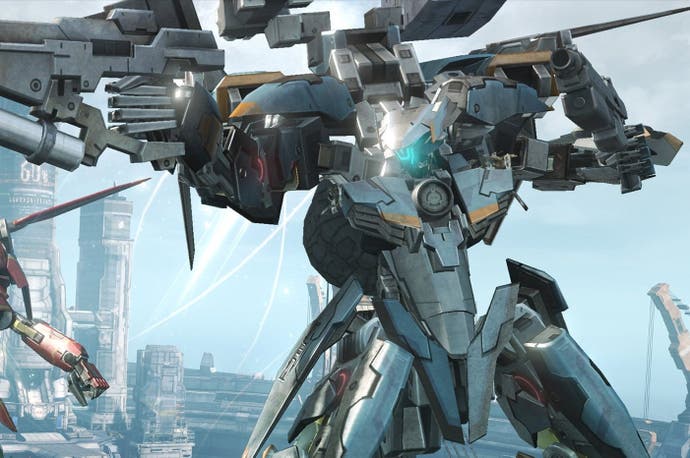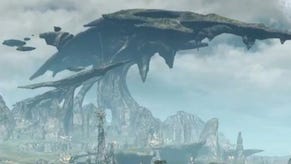Digital Foundry vs Xenoblade Chronicles X
A Wii U technological masterclass?
Released earlier this year in Japan, Xenoblade Chronicles X is now set for release in the West imminently - and it's a game we've kept an eye on for a while now as its scope and sheer technological ambition exceeds expectations. When looking at open world games on PlayStation 3, Xbox 360 and even the Wii U itself, there are scant few that offer a truly stable frame-rate - but that's exactly what we have here. There are certainly sacrifices that had to be made to get there but the end result is nothing short of spectacular for the platform, with a sublime balance between visual ambition and overall performance.
One of the most difficult challenges faced by the development team centres on data management. Without the ability to natively install games to the system's built-in storage, bringing such a large scale title to the system is no small feat. To work around this, owners of the disc based version of the game are able to download 11GB worth of data packs from the Nintendo eShop.
The idea is to minimize the need to access data from the slower disc drive in order to speed up asset streaming and loading times. If you purchase the game through the eShop though, this is unnecessary. We were provided with a digital version of the game so we're unable to test this feature but, in theory, it's a fascinating workaround. Considering that Monolith's Xenosaga Episode 1 on PlayStation 2 is one of the scant few games to support installation on the official PS2 hard drive, it seems that Takahashi's team is always looking for interesting ways to manage game data.
Once we begin the game it's clear that image quality wise, Xenoblade X delivers results in line with other games on the system. That means a 1280x720 rendering resolution with a helping of post-process anti-aliasing and trilinear texture filtering. It's not the game's strong suit, but in general, it works well enough and doesn't significantly detract from the game's more natural locales.
When you first step foot out into the world of Mira, initial impressions are strong - the terrain stretches out far into the distance, huge creatures roam the landscape, and foliage blows gently in the breeze. It's a world that immediately begs to be explored. It's only fitting then that one of the first things you're invited to try involves jumping from your perch atop a cliff out into the world below. It's a pretty serious jump but this moment instantly sets the tone for the freedom you are granted during exploration.
As you start navigating the terrain, you might start to notice some of the subtle but impressive visual touches. Motion blur, for instance, is applied to camera movement and scenery alike helping to accentuate the fast movement speed of the game. Screen-space crepuscular rays are also present with subtle shafts of light emanating from the sun above while a basic ambient occlusion implementation handles contact shadows below. Animation is a huge step up from the previous game with characters that feel more connected to the world during exploration sequences, though some of the cut-scene animations feel rather stiff in comparison.
More impressively, nearly every inch of the game world can be explored in full with nary a loading screen - aside from a couple short instances in New Los Angeles, of course. Not unsurprisingly, trades are made in order to deliver this type of seamless experience. One such compromise can be seen in the game's day/night cycle. Xenoblade X makes use of shadow maps, as you'd expect, but these shadows are completely static. Shadow position does not change based on the location of the sun - they remain completely still until nightfall when they are simply faded out. This doesn't have a significant impact on minute to minute visual quality, but it does sap away a little of the atmosphere typically gained from dynamic time of day cycling.
Alpha texture resolution also takes a hit in the game, impacting the effectiveness of transparency effects. If you look at the edges around objects which intersect with any sort of alpha, you'll notice obvious saw tooth edges. When these effects fill the screen it can even give the impression of a lower overall screen resolution. While the effects work used in battle is hardly distracting, the wispy clouds used to add fog to the terrain definitely stand out. Depth of field, often used in cut-scenes, is also rendered at a low resolution with obvious artefacts visible throughout many sequences. Beyond that, water reflections are limited to basic cube-maps that do not accurately convey the world around it, while such bodies of water also lack any sort of interactions with the player.
More noticeably, Xenoblade X exhibits significant pop-in even when playing the game from a faster external drive. We've tested the game on both the Wii U's internal storage and using an external drive but in both cases, we encountered a significant amount of object pop-in. Running through the city, you'll see huge Skells and crowds of NPCs appear out of thin air just metres from the player. Thankfully, we only found this distracting while exploring New Los Angeles, the game's central hub. Once out in the wild, pop-in can still be observed but it becomes somewhat less noticeable.
Between the internal storage and external drive, we found the external solution to be the superior option here. When moving through large areas, objects and textures often appeared just a touch faster using an external solution. Of course, it's also possible that performance will vary based on the speed and quality of the external device being used with the console.
Another curious thing we noticed stems from the game's collision detection or, more appropriately, the lack thereof. As we run through the city the player ghosts right through the cars, NPCs, and Skell as if they weren't even there. It's not clear if this type of thing is designed to save performance but the results are certainly bizarre.
When it comes to performance, however, things start looking up again. Xenoblade X operates at 30 frames per second with vertical sync engaged at all times and it manages to stick very closely to this target throughout. Open world games such as this often struggle with performance on consoles but we were pleasantly surprised by just how stable this game really is. We encountered a handful of drops in our 15 hours we spent with the game, but by and large, a locked 30fps is achieved. It seems that a great number of the aforementioned compromises were made in pursuit of stable performance. Given the results, we feel the team has made the right choice.
Another interesting facet of the design centres on traversal itself. It often feels as if you can explore areas that would be off limits in many other games. You're not limited to climbing specific sets of stairs or sticking to certain paths - you can really go off as you please. At times, it almost feels as if the game is encouraging you to explore its boundaries. There are paths everywhere that would be inaccessible in a typical open world RPG that can be fully explored in Xenoblade X. It's really quite liberating.
Seeing what has been achieved here gives us hope for the upcoming Zelda title on Wii U. Earlier this year, Monolith Soft posted a number of jobs for support roles which was later clarified by the game's creator Tetsuya Takahashi in an interview noting that "Monolith is currently supporting a handful of other Nintendo projects, specifically projects needing map design and 'interesting adventure elements'." Bearing in mind that Monolith Soft previous helped with The Legend of Zelda: Skyward Sword, it seems likely that the latest Wii U instalment is receiving support as well. While the team responsible for Xenoblade X is separate from the support team, the experience gained in the creation of the game certainly seems like a good fit for an open world Zelda title.
While many of the compromises sound distracting in writing, the reality is that most of the game is designed well enough to overcome these limitations. We're not looking at the latest in graphics technology here, but what the team at Monolith has achieved remains impressive nonetheless. More importantly, the game operates at a very stable frame-rate and feels remarkably polished - two elements which are notoriously difficult to get right in large open world games.
Ultimately, Xenoblade Chronicles X is a beautiful and expansive game. It's also really the only game of its kind on the Wii U right now and it works wonderfully. Even with some of its blemishes, it's hard not to be impressed by what has been achieved on Nintendo's home console. The slick presentation, rich gameplay, and incredible soundtrack all comes together to create one of the most polished open world experiences we've encountered in quite some time - even in the face of obvious technical compromises. Looking back over Monolith Soft's catalogue of games, we feel confident in saying that Xenoblade Chronicles X is its most impressive title to date.


















